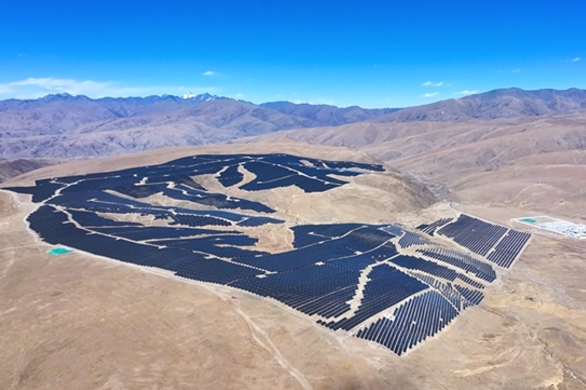
The Phase I plant is located in Jiawa Village and comprises 250 MW of solar capacity alongside a 50MW/200MWh electrochemical energy storage system. The storage unit is designed to absorb excess solar power during daylight hours and release up to 200 MWh of electricity over four hours at night, significantly improving local energy reliability and balancing power demand during peak periods.
The project was developed by Huaneng Yarlung Tsangpo Hydropower Development Co., Ltd., a subsidiary of Huaneng Group. Construction officially began in February 2024, and the plant was connected to the grid by the end of March 2025, following 13 months of intensive construction under some of the world’s most challenging conditions.
The project site experiences oxygen levels just 60% of those at sea level, ultraviolet radiation two to three times higher, and temperature swings of nearly 30 C between day and night. The harsh environment limited the annual construction window to less than six months, requiring the team to overcome difficulties including altitude sickness, extreme weather, and reduced machinery efficiency.
Huaneng’s construction team noted that the project yielded China Huaneng Group, a major state-owned power generation company, has successfully connected its Jiawa Phase I solar-plus-storage plant to the grid in Qusong County, Shannan City, Tibet Autonomous Region. Located at over 4,500 meters above sea level, this facility now stands as Tibet’s largest completed solar-storage project, with plans for further growth in later phases.
Situated in Jiawa Village, the Phase I plant features 250 MW of solar capacity paired with a 50 MW/200 MWh electrochemical storage system. The storage unit captures surplus solar energy during the day and releases up to 200 MWh over four hours at night, enhancing energy stability and meeting peak demand in the region. Developed by Huaneng Yarlung Tsangpo Hydropower Development Co., Ltd., a Huaneng subsidiary, construction started in February 2024 and concluded with grid connection by late March 2025 after 13 months of work.
The site’s extreme conditions posed significant challenges, with oxygen levels at 60% of sea level, ultraviolet radiation two to three times higher, and temperature shifts of nearly 30°C daily. These factors restricted construction to less than six months annually, forcing the team to navigate altitude sickness, harsh weather, and reduced equipment performance. Huaneng’s team highlighted that this experience has built expertise for future high-altitude projects in Tibet, Qinghai, Xinjiang, and similar areas.
When fully operational, Jiawa Phase I is projected to produce around 370 GWh of electricity each year, helping to ease power shortages during high-demand periods in Tibet. The project also marks a key part of Huaneng’s Yalong River clean energy base, planned in three phases to reach 850 MW total capacity. Phases II and III will follow, supporting Huaneng’s goal to expand renewable energy in Tibet, often called the roof of the world.
This achievement underscores Huaneng’s capability to deliver large-scale clean energy solutions in demanding environments, strengthening Tibet’s energy infrastructure with a blend of solar and storage technology. The Jiawa plant sets a foundation for future developments in the region’s renewable energy landscape.valuable experience in high-altitude engineering, laying the groundwork for future large-scale projects in Tibet, Qinghai, Xinjiang, and other similarly challenging regions.
Once fully operational, the Jiawa Phase I project is expected to generate approximately 370 GWh of electricity annually and play a vital role in alleviating power shortages during peak periods in Tibet.
The Jiawa plant also serves as a flagship project for Huaneng’s Yalong River clean energy base, which is planned in three phases totaling 850 MW. Construction on Phases II and III is scheduled to follow as part of Huaneng’s broader strategy to accelerate clean energy deployment in Tibet, the roof of the world.